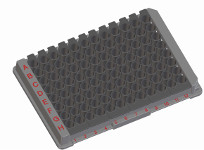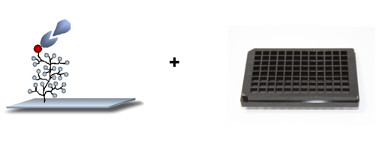Functionalized 96-well Plates for Microarrays
In order to take advantage of the existing liquid handling and automation solutions for 96-well SBS formats, PolyAn is offering a range of functionalized multiwell products which are equipped with the same reactive surfaces as our glass and plastic slides.

Products
3D-Epoxy 96-well µClear® microplate, PS, black
| Id | 00 691 251 |
| Title | 3D-Epoxy 96-well µClear® microplate, PS, black |
| Substrate | PS plate |
| Format | 96-Well µClear® plate, polystyrene, black |
| Mean Diameter | |
| Color Labeling | |
| Surface Modifications | 3D-Epoxy |
| Solids Content | |
| Product Dimensions | 85 x 128 x 14 mm |
| Packaging | |
| Packaging Volume | 4 Plates/Box |
| Package Weight | 158 g |
| Dimensions | 128 x 86 x 45 mm |
| Hts Code | 39 26 90 97 |
| Pads Wells | 96 |
| Pad Size | |
| Well Format | µClear® |
| Product Thickness | |
| Description | PolyAn's 3D-Epoxy functionalized 96-well microplates are used for covalent immobilization of biomolecules. Epoxides are cyclic ethers with a highly strained three member ring. Epoxy rings can be easily reacted with nucleophiles e.g. amines, hydrazines, thiols, hydroxides and carboxyl groups. |
| Image |
Standard polystyrene 96-well plates in different designs which are equipped with PolyAn’s 3D-Epoxy and 3D-NHS reactive matrices for covalent coupling of biomolecules.
Key features:
- Compatible with all liquid handling systems for ELISA
- Covalent binding of nucleophiles to the plate surface without complex coupling chemistry
- Integrated antifouling matrix reduces unspecific binding
- No cross-contamination between wells possible
- Most cost-efficient solution
Multipart plates
PolyAn’s multipart plates are comprised of a functionalized glass plate (75 x 110 mm, 1mm thickness) which is combined with the ProPlate superstructure after the printing process.

Products
3D-Epoxy 96-well µClear® microplate, PS, black
| Id | 00 691 251 |
| Title | 3D-Epoxy 96-well µClear® microplate, PS, black |
| Substrate | PS plate |
| Format | 96-Well µClear® plate, polystyrene, black |
| Mean Diameter | |
| Color Labeling | |
| Surface Modifications | 3D-Epoxy |
| Solids Content | |
| Product Dimensions | 85 x 128 x 14 mm |
| Packaging | |
| Packaging Volume | 4 Plates/Box |
| Package Weight | 158 g |
| Dimensions | 128 x 86 x 45 mm |
| Hts Code | 39 26 90 97 |
| Pads Wells | 96 |
| Pad Size | |
| Well Format | µClear® |
| Product Thickness | |
| Description | PolyAn's 3D-Epoxy functionalized 96-well microplates are used for covalent immobilization of biomolecules. Epoxides are cyclic ethers with a highly strained three member ring. Epoxy rings can be easily reacted with nucleophiles e.g. amines, hydrazines, thiols, hydroxides and carboxyl groups. |
| Image |
Key features:
- Fast printing on planar surface
- No electrostatic effects
- All of PolyAn’s reactive matrices available for coupling
- Functionalized bottom plate can be comprised of glass, PMMA, COP and other plastics
Functionalized glass sheets
Functionalized glass sheets without superstructure in 1 mm thickness. The size of the glass sheets is optimized for use with standard 96-well and 384-well superstructures. Other surfaces and thinner glass supports are available upon request.
Products
3D-Epoxy 96-well µClear® microplate, PS, black
| Id | 00 691 251 |
| Title | 3D-Epoxy 96-well µClear® microplate, PS, black |
| Substrate | PS plate |
| Format | 96-Well µClear® plate, polystyrene, black |
| Mean Diameter | |
| Color Labeling | |
| Surface Modifications | 3D-Epoxy |
| Solids Content | |
| Product Dimensions | 85 x 128 x 14 mm |
| Packaging | |
| Packaging Volume | 4 Plates/Box |
| Package Weight | 158 g |
| Dimensions | 128 x 86 x 45 mm |
| Hts Code | 39 26 90 97 |
| Pads Wells | 96 |
| Pad Size | |
| Well Format | µClear® |
| Product Thickness | |
| Description | PolyAn's 3D-Epoxy functionalized 96-well microplates are used for covalent immobilization of biomolecules. Epoxides are cyclic ethers with a highly strained three member ring. Epoxy rings can be easily reacted with nucleophiles e.g. amines, hydrazines, thiols, hydroxides and carboxyl groups. |
| Image |
Customized surfaces
Please do not hesitate to contact us, if you require a special surface for binding of your biomolecules that is not listed in the products table. We can also functionalise other plate formats and substrates with our surfaces. Additionally, we have access to a wide range of different surface modifications for binding of small molecules, saccharides etc.
